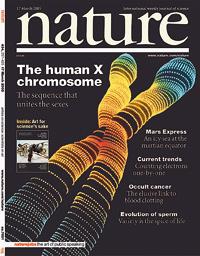Chromosome X in light

The X chromosome has always been interesting for scientists. Although they still did not know anything called chromosome, the researchers tried to answer questions related to the X chromosome. For example, for centuries they have tried to know what was the key to inheriting hemophilia and daltonism. Why are men all sick and there are hardly any women with these diseases? What makes us different men and women?
The answers were little by little and the biggest breakthrough was given a hundred years ago. In fact, Stevens and Wilson published in 1905 two works in which they exposed the responsibility of chromosomes when deciding sex. Both researchers suggested that men have a chromosome that women do not have. To reach this conclusion, the chromosomes of insect gametes were microscopically analyzed and realized that half of the sperm contained a chromosome that did not appear in the eggs. In his opinion, this was of great importance when it came to being one sex or another.
Other researchers recently described the X chromosome, but Stevens and Wilson went further and proposed that the small chromosome detected in sperm was a pair of the X chromosome. According to them, chromosomes were arranged in pairs and, since eggs always had an X chromosome, sperm had X or Y, one of them. Thus, women would have two X chromosomes and men an X and an Y.

Also, if this were so, the last question had a simple answer: If on the X chromosome there is a mutation that produces the disease, on the Y chromosome there is no copy that compensates for the error. Hence, many diseases are more frequent in men and very rare in women.
And yes, those researchers who a hundred years ago worked correctly. From that moment on, geneticists have been clarifying aspects related to the
X chromosome and have finally come to decoding step by step.
Why is it interesting?
Clarification of the X chromosome sequence is an important step: The news appeared on the cover of Nature! It is not an easy achievement, as it is one of the most prestigious scientific journals. And it also had repercussions in other media.

At least for Andone Estonbara, who operates in the Faculty of Science and Technology of the UPV/EHU, it is no wonder that research is so important. According to him, “the X chromosome of mammals has unique characteristics that have been generated by evolution as a consequence of the existence of a sexual chromosome in both males and females. And knowing the entire sequence of the X chromosome has paved the way for exploring its evolution and those unique features at another level.”
For example, decoding the X chromosome has served to illustrate the evolution of sex chromosomes. Of the 46 human chromosomes, two are sexual chromosomes—X and Y—and the rest are called autosomes. The sequence of the X chromosome has been compared with other species and the Y chromosome. They discover that the ancestor of the X and Y chromosomes was autosomal and that the X chromosome holds most of its original information.
More details have been clarified. Estonba explains them: “Apparently, this original was stuck with some other autosome and the X chromosome would be the result of it all. Therefore, there was initially an autosomal chromosome from which the sexual chromosomes, X and Y derive. And also, in the case of X, that chromosome was attached part of another. The Y chromosome would have the same precursor as the X chromosome, but losing the possibility of recombining with the X chromosome, it has deteriorated over time. In the end, the two sex chromosomes are totally different from each other.”
Particularity of the X chromosome
The X chromosome has a number of characteristics that characterize it. Compared to autosomes, the X chromosome has few genes, with 1,098 genes being counted. In addition, they are on average lower than autosomal genes. That is, it has fewer genes and smaller than autosomes.

There are two hypotheses that explain why. On the one hand, that original autosoma might have few genes in itself. But there is also the possibility that in the evolution of mammals, classes of autosomal genes with selection-driven X chromosomes are passed. And in the opinion of Andone Estonba it is very likely that it was so.
However, genes collected by the X chromosome have important functions, not all of them related to sex determination. A significant example is found in MAGE genes. These are much more abundant on the X chromosome than on the rest of the chromosomes, on the X chromosome there are 32 of this type and in the rest only 4. The MAGE gene group is expressed in certain cancers, while in healthy tissues its expression is limited to the testicles.
They still don't know much about these genes, but the fact that on the X chromosome they are more abundant than on other occasions suggests that they may be beneficial for males.
Disease occurs just the other way around. In this case, it is counterproductive that the gene is on the X chromosome. In fact, a lot of recessive diseases related to the X chromosome are known. Andoni Estonba clearly explains the reason: “Why are they so familiar? It is easy because they are detected immediately. Whenever there is mutation on the male X chromosome, you have deafness. In autosomes, being in pairs, it is enough that the other chromosome has a healthy copy of the gene so as not to highlight the disease.”

In total, researchers know the molecular basis of 168 X-related diseases, and know which genes or mutations cause the disease. Of these 16 are related to mental retardation.
No junk DNA
Another special feature of the X chromosome is related to repeated sequences. In fact, it has many such sequences. A lot. In fact, it is not uncommon for repeated and supposedly useless fragments to appear. In the genome there are many parts of this type, almost half of the genome is formed by repetitive sequences. Some of them are recurrent, abundant, and scattered throughout the genome. Some are short, they are called SINE and others are long, LINE.
For on the X chromosome there are fewer genes and SINE sequences than in autosomes. In contrast, LINE sequences are much more numerous than others. In addition, they build up a lot around the inactivation zones of the X chromosome.

of the two X chromosomes in embryo cells makes variability so
large.
It should be noted that in women one of the two X chromosomes is inactive, otherwise they would have duplicated information with men. But there are parts that escape the inactivation process (about 15%). As Estonba explains, “the theory is that these LINE elements act as stations in the inactivation process. In this way, there is an inactivation in the place where there are many LINE elements and where there is little or nothing, there is no inactivation”.
The LINE sequences are a clear example of how important those sections that were formerly called DNA Trash can be. However, there are many sections left to read.
But now they have the book in their hands and, as they get the reading keys, researchers will be able to understand the secrets of the X chromosome. Surely the book continues to surprise.
Tricolor cats and female mosaics
Some cats have a special coat. They have three colors: red, black and white, with spots scattered by each color. There are no two cats equal but they all have something in common: they are all females. The key is the inactivation of the X chromosome.
In females, one of the X chromosomes is inactive within weeks of fertilization. The embryo still has few cells and one of them is randomly inactivated. The entire cell line that is derived from each cell will also have that X inactive, being one in some females and another in others.

How does inactivation occur? On the X chromosome there is an area called XIC (X-Inactivation Centre) where the XIST gene is located. Both the area and the gene are found in two X chromosomes, both active. However, in one of them the XIST gene is calmed at a given time and in the other it continues. And as it progresses, the X chromosome becomes inactive.
In fact, the XIST gene produces a small RNA that becomes inactive as this molecule covers the X chromosome. It seems that for this, the elements called LINE are key, since they are the stops of the inactivation path. This inactivates the locations where there are many LINE elements and not others.
Researchers have also analyzed how the activity of the XIST gene remains and concluded that the inactivation process is as complex as it is interesting.
The result is sometimes striking. An example is the cat in the image, which has a color on the hair based on the chromosome that has not been inactivated. That is, if the inactivated X chromosome had a black allele on his skin, the derivatives of this cell have given red color to the hair. The opposite is true of black places, whose cells come from a cell in which the red allele chromosome was silenced.
In women, being female mammals, the same thing happens. For example, in the case of color blindness, women may have one daltonic eye and the other may not. That's why geneticist Andone Estonba says: “As for the X chromosome, women are mosaics.”





